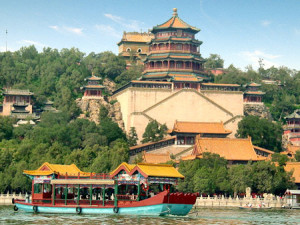Exploring Beijing heart
The central areas around the Palace Museum (Forbidden City) and city gates as well as the lakes – ZhongNanHai, BeiHai and HouHai – have been designated as protected landmark districts that retain the features of Old Beijing. The Forbidden City at the centre is surrounded in concentric circles by the Inner City and Outer City.
 Also known as the Palace Museum, the Forbidden City is truly the spot to appreciate the might and grandeur of the Imperial Chinese court during the height of its power in the Ming and Qing dynasties. Get there when the gates open (around 8.30am) if you want to walk through the vast and spectacular courtyards in relative peace.
Also known as the Palace Museum, the Forbidden City is truly the spot to appreciate the might and grandeur of the Imperial Chinese court during the height of its power in the Ming and Qing dynasties. Get there when the gates open (around 8.30am) if you want to walk through the vast and spectacular courtyards in relative peace.
A good place to start exploring the city is Tiananmen Square, built by Mao to impress, is the largest square in the world and is the place where Mao Tse Tung declared the foundation of the People’s Republic. It is surrounded by Soviet-style monuments and government buildings, and houses Mao’s mausoleum on the opposite side of the Forbidden City entrance. Today, the Square is more closely identified with the suppression of the student-led pro-democracy protests of spring 1989.
The Lama Temple or Palace of Peace, was built by Chinese emperors who harboured a deep fascination for the Tibetan (Tantric) version of Buddhism. Over the years many Tibetan and Mongolian monks lived and taught here, and there are still monks in residence today. The temple is famous for its 18m statue of Maitreya Buddha carved from a single piece of sandalwood.
Winter Palace or Beihai is a good place to take a glance at Zhongnanhai, the heart of Communist China. The counter part of a beautiful white pagoda of 17th century and of a peaceful island in the middle of the park, is a skyline made up of giant Government buildings (PRC’s Ministry of Defence and General Staff). Before you leave the park, visit some small but beautiful gardens on the north bank.
The Hutong Villages of Beijing most represent the traditional housing of Chinese locals and are the perfect place to get a glimps of Chinese daily life. Unfortunately, the majority of Hutongs have been demolished to make space for modern buildings. Better see these typical Hutong Villages with rickshaws that can weave in and out of their narrow streets.
Another interesting experience that will let you feel a vibe of China’s ancient traditions, is an early morning visit to one of Beijing’s public parks. This is when people indulge in their particular physical activities as Tai Chi, jogging, singing or even ballroom dancing.
Temple of Heaven, located on south east of the Tiananmen Square, is not only a beautiful sight, but also the greenest public park of Beijijng. The temple itself was the site where the emperor prayed every year for good harvests and fair weather.Very popular with local residents practicing tai chi, dancing and other activities in the mornings and on weekends, the Temple of Heaven is home to many ancient trees, peaceful woods and amazing solitude.
Fragrant Hills, in the north-western corner of Beijing, is a good place for weekend outings and picnics. Formerly a Qing imperial garden, today Fragrant Hills makes an easy short climb in the suburbs of Beijing. It’s also home to the Fragrant Hills Hotel, designed by I.M. Pei (Louvre Museaum Pyramid).
Beijing Botanical Gardens, just steps away from the east gate of Fragrant Hill, offer acres of greenery and flowers for those tired of urban smog and traffic noise. Sir Johnston, teacher of the last emperor Puyi, had a villa in Cherry Glen, a silent and beautiful retreat in the Gardens. In the spring, the gardens hosts special exhibits of tulips, peach, plum blossoms and peonies.
Home to extensive gardens and ruins of palaces constructed by the Qing emperors, the enchanting Summer Palace lies 20 kilometres northwest of the centre of Beijing. It is the largest imperial garden in existence in China. The whole Summer Palace covers an area of over 290 hectares including more than 3,000 buildings, such as halls, pavilions, towers and so on. See the spots on the west bank and back hill areas where there are some secret ruins, caves, and other fun stuff.
For accommodation while in China’s capital see the following hotels, guest houses ( or Bed and breakfast) and youth hostels available from 4 euros per person per night: Beijing Saga Youth hostel, Beijing 9 Dragons Youth hostel, Beijing Swan Inn BB, Beijing Hutongren, Beijing Autumn Garden Courtyard Hotel, Beijing Spring Courtyard Hotel, Beijing Feiying International Youth hostel, Beijing Meridian hotel, Beijing Hutong Inn, Beijing temple side Guest house, Beijing Perfect Inn Boutique hotel, Beijing Zhongtang Hotel, Beijing Xiangyun Apartments Season’s Park, Beijing New Experience Courtyard hotel, Beijing City centre International Youth hostel.










